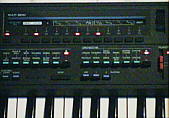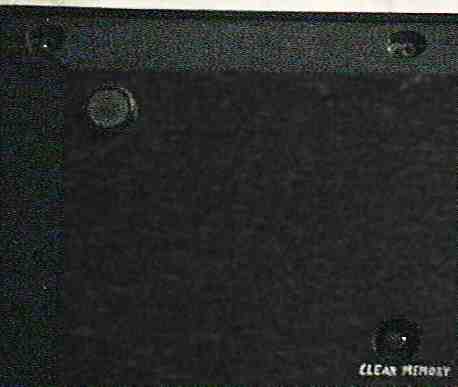Yamaha MK-100
(nice digital synthesizer with lovely pop organ sounds & tekkno drum
computer)
Unlike most portable keyboards, this 1983er Yamaha PortaSound
perfectly represents the sweet sounding early 1980th pop organ estheticism.
Particularly the "duet" and "trio" mode with layered sounds and "stereo
symphonic" pseudo- leslie would fit perfectly into the environment of the
famous WERSI Helios or Yamaha Electone organ concerts by
Klaus Wunderlich or Franz Lambert of that era. The thing also has nice
sounding synthesizer functions, although these are very limited because
they only combine some preset envelopes with preset waveforms. Unfortunately
it has not the organ volume pedal jack of the earlier PortaSounds, but
this could certainly be upgraded if necessary. There is also a sequencer
and a realtime programmable drum computer with bizarre electronic blip
percussion that may be great for tekkno.

main features:
-
49 mid size keys
-
mono sound, stereophonized by "stereo symphonic" leslie simulator (2 speeds)
-
polyphony 8 notes (drastically reduced when duet/ trio or melody mixer
active)
-
12 semi- OBS preset "orchestra" sounds {organ, trumpet, saxophone, piano,
harpsichord, synthe 1 | piccolo, violin, oboe, music box , guitar, synthe
2} (selected through 6 locking OBS buttons + bank switch button)
-
12 semi-OBS preset rhythms {disco, rock'n'roll, 8 beat, rhumba, swing ,
march | 16 beat, shuffle, bossanova, samba, slow rock, waltz} (selected
through 6 locking OBS buttons + bank switch button. Each rhythm has each
3 switchable bass and chord variations.)
-
locking push button switches to select sounds, rhythms and sustain
-
sustain {off, depth 1, depth 2} (selected through locking buttons)
-
vibrato
-
fingered & single finger accompaniment (manual chord mode with rhythm
off)
-
rhythm fill- in button (left, next to the keys)
-
sliders for master volume & tempo
-
bass & rhythm volume slide switches (each 5 steps)
-
transpose knob (-5..+6 semitones)
-
"custom drummer" (all rhythms and accompaniments are re- programmable!)
-
"multi-menu": a row of 12 buttons + mechanical 9 page scroll menu to select
functions.
-
synthesizer: all "orchestra" sounds can be re- programmed; every sound
consists of 2 sub- oscillators of those each can select 1 of 4 preset envelopes
and 1 of 4 preset waveforms (timbres). The waveform and timbre sets of
both sub- oscillators are different and not editable. Every sound can have
vibrato on or off.
-
every rhythm and "orchestra" sound can be switched between edited and preset
version without overwriting the edited one.
-
"melody mixer": To the highest held note can any of the other sounds be
layered.
-
bass and chord accompaniment voice is selectable from any of the "orchestra"
sounds
-
multi- track sequencer (melody, chord, bass) with cassette saving
-
sound generator based on static digital waveforms + envelope; at low tones
sample aliasing gets audible. The drums sound like squarewave blips,
the hihats sound somewhat metallic and may be shift register noise or a
very low res waveform sample. The mixed digital sound is outputted mono
through 1 common resistor array DAC (8 bit?) and then post- processed by
the analogue leslie simulator. The PCB of this instrument is quite large
and has at least the complexity and component count of a C64 homecomputer.
-
battery backed up RAM
-
jacks for line out, headphone, AC adapter and data cassette.
 This
is the "Multi-Menu"; the menu pages are printed on a black plastic prism
that rotates by turning the right knob. Menu items are selected by pressing
the buttons below. LEDs above this button row indicate which functions
are currently selected. This kind of menu was also used in Yamaha Electone
home organs (e.g. ME-50, seen on eBay). Later Yamaha abused
the term "Multi-Menu" on Yamaha PSS-470, despite it had no plastic
prism anymore but only ordinary OBS buttons and slide switches those have
nothing to do with a menu. This
is the "Multi-Menu"; the menu pages are printed on a black plastic prism
that rotates by turning the right knob. Menu items are selected by pressing
the buttons below. LEDs above this button row indicate which functions
are currently selected. This kind of menu was also used in Yamaha Electone
home organs (e.g. ME-50, seen on eBay). Later Yamaha abused
the term "Multi-Menu" on Yamaha PSS-470, despite it had no plastic
prism anymore but only ordinary OBS buttons and slide switches those have
nothing to do with a menu. |
eastereggs:
-
Likely the sequencer data from the cassette jacks could be read into PC
and converted into MIDI files and vice versa so far anybody finds out the
data format (possibly it might be similar like the PlayCard data
of my Yamaha PC-100).
modifications:
-
memory reset button added (shorts the electrolytic cap when pushed).
notes:
The previous owner had built this instrument into a home- made aluminium
carry case, which was quite heavy, sharp edged and came with a set of oxidized
thin brass poles those could be awkwardly assembled to form the legs of
a crude and wacky keyboard stand. Due to the poles had lain upon the the
instrument when not in use, the control panel of mine is badly scratched
around the multi- menu.
Warning: Hmm... The thing stores all settings in battery backed
up RAM; with no batteries inserted the RAM is backed up by a large electrolytic
capacitor for a few days(?). When the cap runs empty, this messes up the
data badly and even causes things to subtly malfunction those normally
were expected not to be RAM dependant. E.g. sometimes particular preset
sounds plays too silent or certain parts of them refuse to be editable,
or their LEDs show mess or sustain doesn't work or even the chord volume
slide switch refuses to change volume at some positions (e.g. only 2 of
the 5 positions have different volume). These flaws can drive you crazy
and make you take the entire thing apart for hours to successlessly search
for dirty switches etc. etc. and even in the manual I downloaded from Yamaha
there is no reset procedure for this keyboard explained to prevent this.
(In manuals of later Yamaha PortaSounds with battery backed up RAM
stands usually that certain simultaneous button presses reset the thing.)
 As
a fix I installed a memory reset button that shorts the electrolytic cap
when pushed. I wired a 100 ohm resistor in series to the button to prevent
damage of the charged cap or power supply when accidentally pressed with
power supply connected or batteries inserted. This way the button needs
to be pressed for about 20s to take effect, but this also helps to prevent
accidental memory deletion. I mounted the button in one of the bottom screw
holes to protect it from accidental operation. (It would certainly also
be possible to place an "opener" button switch into the RAM power supply
line, which also could be useful as shitshot, but due to opener switches
sometimes fail by oxidization, I yet didn't dare this to avoid accidental
data corruption.) As
a fix I installed a memory reset button that shorts the electrolytic cap
when pushed. I wired a 100 ohm resistor in series to the button to prevent
damage of the charged cap or power supply when accidentally pressed with
power supply connected or batteries inserted. This way the button needs
to be pressed for about 20s to take effect, but this also helps to prevent
accidental memory deletion. I mounted the button in one of the bottom screw
holes to protect it from accidental operation. (It would certainly also
be possible to place an "opener" button switch into the RAM power supply
line, which also could be useful as shitshot, but due to opener switches
sometimes fail by oxidization, I yet didn't dare this to avoid accidental
data corruption.) |
The MK-100 sounds very much like when Yamaha attempted to replicate
the timbre of their in the same year released digital DX7 FM synthesizer
on cheaper non- FM hardware, thus this instrument sounds very different
from the rather muffled analogue timbre of my first PortaSound generation's
PS-2.
The preset "organ" sound is rather a clicking Hammond than church
style and also the "piano" sounds more like an electric than acoustic one;
all sounds are very FM- like (except there are no "dwellngs" or other drastic
timbre changes in them, but the layered envelopes and sounds still permit
slowly fading timbres). The locking push buttons were likely taken from
the previous analogue PortaSounds where their multiple contacts had been
technically necessary. The sustain of the "music box" sound stays always
at depth 2 and can not be switched. The rhythm of this Yamaha uses
a row of 3 green and 1 red LED as optical metronome; my Fujitone
6A has a similar LED chain, which may have been inspired by it. While
the main sounds are best suited for harmonious pop organ chords or sweet
disco music, the strange sounding and programmable drum section can also
be interesting for tekkno or other gunk structured music, not least because
the custom drummer patterns can be played in live performances by deleting
and re- entering a percussion sound while the others keep playing in a
loop.
If you want to know more about details, it is a good idea to download
the manual from Yamaha.
In 1985 a very simplified variant of the MK-100 without the multi-
menu synthesizer was released as Yamaha PSS-450 (seen on eBay).
The same sound hardware was likely also employed in the fullsize Yamaha
PS-55 (stereo) and its simplified variants PS-35 (stereo) and
PS-25
(mono), those had similar looking controls (but no Multi- Menu) and also
came out in 1983 (as successors of the Yamaha
PS-30 and PS-20).
Similar sounds like the Yamaha MK-100 (trio mode etc. but no synth, 49
midsize keys) has also the Amstrad Fidelity
CKX100.
| removal
of these screws voids warranty... |
|
|
 |

|
|
| |
back
|
|
